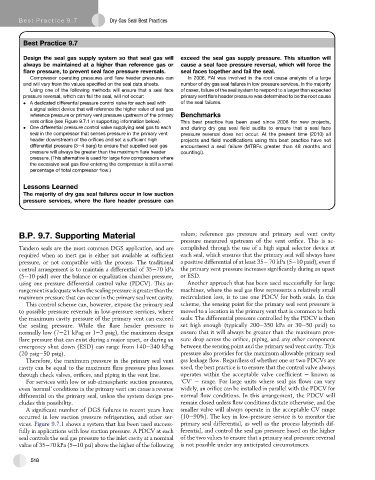Page 547 - Subyek Teknik Mesin - Forsthoffers Best Practice Handbook for Rotating Machinery by William E Forsthoffer
P. 547
Be st Practice 9 .7 Dry Gas Seal Best Practices
Best
Best Practice 9.7Practice 9.7
Design the seal gas supply system so that seal gas will exceed the seal gas supply pressure. This situation will
always be maintained at a higher than reference gas or cause a seal face pressure reversal, which will force the
flare pressure, to prevent seal face pressure reversals. seal faces together and fail the seal.
Compressor operating pressures and flare header pressures can In 2006, FAI was involved in the root cause analysis of a large
and will vary from the values specified on the seal data sheets. number of dry gas seal failures in low pressure services. In the majority
Using one of the following methods will ensure that a seal face of cases, failure of the seal system to respond to a larger than expected
pressure reversal, which can fail the seal, will not occur: primary vent flare header pressure was determined to be the root cause
A dedicated differential pressure control valve for each seal with of the seal failures.
a signal select device that will reference the higher value of seal gas
reference pressure or primary vent pressure upstream of the primary Benchmarks
vent orifice (see Figure 9.7.1 in supporting information below). This best practice has been used since 2006 for new projects,
One differential pressure control valve supplying seal gas to each and during dry gas seal field audits to ensure that a seal face
seal in the compressor that senses pressure in the primary vent pressure reversal does not occur. At the present time (2010) all
header downstream of the orifices and set a sufficient high projects and field modifications using this best practice have not
differential pressure (3e4 barg) to ensure that supplied seal gas encountered a seal failure (MTBFs greater than 48 months and
pressure will always be greater than the maximum flare header counting!).
pressure. (This alternative is used for large flow compressors where
the excessive seal gas flow entering the compressor is still a small
percentage of total compressor flow.)
Lessons Learned
The majority of dry gas seal failures occur in low suction
pressure services, where the flare header pressure can
B.P. 9.7. Supporting Material values; reference gas pressure and primary seal vent cavity
pressure measured upstream of the vent orifice. This is ac-
Tandem seals are the most common DGS application, and are complished through the use of a high signal selector device at
required when an inert gas is either not available at sufficient each seal, which ensures that the primary seal will always have
pressure, or not compatible with the process. The traditional a positive differential of at least 35e 70 kPa (5e10 psid), even if
control arrangement is to maintain a differential of 35e70 kPa the primary vent pressure increases significantly during an upset
(5e10 psid) over the balance or equalization chamber pressure, or ESD.
using one pressure differential control valve (PDCV). This ar- Another approach that has been used successfully for large
rangementisadequatewhenthesealingpressureisgreaterthanthe machines, where the seal gas flow represents a relatively small
maximum pressure that can occur in the primary seal vent cavity. recirculation loss, is to use one PDCV for both seals. In this
This controlschemecan,however,exposetheprimaryseal scheme, the sensing point for the primary seal vent pressure is
to possible pressure reversals in low-pressure services, where moved to a location in the primary vent that is common to both
the maximum cavity pressure of the primary vent can exceed seals. The differential pressure controlled by the PDCV is then
the sealing pressure. While the flare header pressure is set high enough (typically 200e350 kPa or 30e50 psid) to
normally low (7e21 kPag or 1e3psig),the maximumdesign ensure that it will always be greater than the maximum pres-
flare pressure that can exist during a major upset, or during an sure drop across the orifice, piping, and any other component
emergency shut down (ESD) can range from 140e340 kPag between the sensing point and the primary seal vent cavity. This
(20 psige50 psig). pressure also provides for the maximum allowable primary seal
Therefore, the maximum pressure in the primary seal vent gas leakage flow. Regardless of whether one or two PDCVs are
cavity can be equal to the maximum flare pressure plus losses used, the best practice is to ensure that the control valve always
through check valves, orifices, and piping in the vent line. operates within the acceptable valve coefficient e known as
For services with low or sub-atmospheric suction pressures, ‘CV’ e range. For large units where seal gas flows can vary
even ‘normal’ conditions in the primary vent can cause a reverse widely, an orifice can be installed in parallel with the PDCV for
differential on the primary seal, unless the system design pre- normal flow conditions. In this arrangement, the PDCV will
cludes this possibility. remain closed unless flow conditions dictate otherwise, and the
A significant number of DGS failures in recent years have smaller valve will always operate in the acceptable CV range
occurred in low suction pressure refrigeration, and other ser- (10e90%). The key in low-pressure service is to monitor the
vices. Figure 9.7.1 shows a system that has been used success- primary seal differential, as well as the process labyrinth dif-
fully in applications with low suction pressure. A PDCV at each ferential, and control the seal gas pressure based on the higher
seal controls the seal gas pressure to the inlet cavity at a nominal of the two values to ensure that a primary seal pressure reversal
value of 35e70 kPa (5e10 psi) above the higher of the following is not possible under any anticipated circumstances.
518

